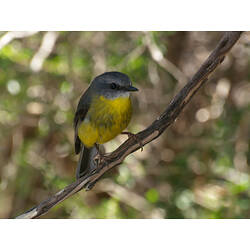General Description
Underparts yellow, back and head grey, rump olive-yellow. Small white throat patch. Wings with pale streaks. Eyebrows pale grey. Bill to tail length up to 17 cm. Call a distinctive monotonous piping call.
Biology
One of Australia's easiest to observe robins, often seen perched sideways on tree trunks. These robins are one of the earliest birds to call in the morning before dawn. They eat insects, spiders and other invertebrates, which they pounce on from a low perch. They typically forage alone. Females weave a cup-shaped nest in a tree fork. They bind grasses and bark together using spider web and then they line the nest with leaves and grasses. Females lay and incubate up to three clutches of two to three eggs each year. Young birds are raised by both parents, and sometimes other helpers. Eastern Yellow Robins are altitudinal migrants, moving to lower areas during winter. Their call is a a distinctive part of the dawn chorus.
Distribution
Eastern and south-eastern mainland Australia.
Habitat
Forests and woodlands that have a thick understorey and urban areas.
More Information
-
Animal Type
-
Animal SubType
-
Brief Id
A medium-sized inquisitive robin with yellow breast.
-
Colours
Yellow, Grey
-
Maximum Size
17 cm
-
Habitats
-
Diet
Carnivore
-
Diet Categories
Insects, Invertebrates
-
Endemicity
-
Commercial
No
-
Conservation Statuses
CITES: Not listed, FFG Threatened List: Not listed, EPBC Act 1999: Not listed, IUCN Red List: Least Concern
-
Taxon Name
-
Common Name
Eastern Yellow Robin
-
Kingdom
-
Phylum
-
Subphylum
-
Class
-
Order
-
Family
-
Genus
-
Species Name
australis











